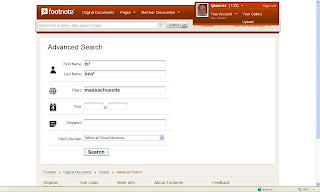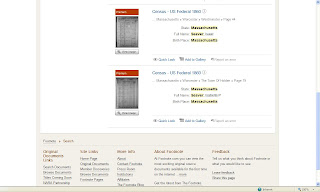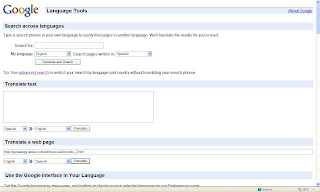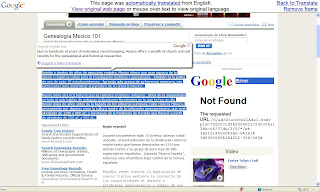I see that
DearMYRTLE is gazing into her crystal ball and trying to predict what is coming to the genealogy world in 1 year, 5 years and 10 years - see
here and
here so far. She apparently is not the only one - Lisa Alzo is writing an article for
Family Chronicle magazine and has asked several "inside the library" folks to opine and pontificate about the future. Great - I can hardly wait to read what they think.
Like many other bloggers, I have considered this question in past posts, including:
*
The Crystal Ball: Part 1 - Will all records be digitized? (11 April 2007)
*
Crystal Ball: Part 2 - Digitizing Records (21 June 2007)
*
The Future of Genealogy - Part 1 (1998 version) (31 October 2007)
*
The Future of Genealogy - Part 2 (2004-5) (1 November 2007)
*
The Future of Genealogy - My Turn (1 November 2007)
*
Genealogy in the 21st Century - Predictions (9 February 2009)
I really tried back in 2007 to sort it all out, but seemed to be hampered by not being inside the genealogy industry (and I'm still not an "insider") and having a lack of vision. Just two years ago, I doubt that many genealogists even knew about Facebook or Twitter, genea-blogging was relatively new, genealogy videos and webinars were in their infancy, and the genealogy software programs did not have the web search, maps or source citation features that many programs now have.
I wasn't asked, but I will ask my questions and provide my opinions anyway (because that's what I like to do!):
1) Will New FamilySearch live up to its' potential? New FamilySearch is coming online slowly to LDS members (and still isn't available in Utah and Idaho), as it tries to sort out the problems of the latest "Mother of all Genealogy Databases." It's hard work! I don't doubt that it will become a reality, but it may be several years away. Likewise the volunteer FamilySearch Indexing project. The databases already imaged and indexed are a small fraction of what is on the FHL microforms - they say it will be done in about ten years. Realistically, I doubt that - perhaps 20 years (have you read all of those films? My God, some are hard to read).
2) What is the next great thing in genealogy web sites? Coming onto the near-future horizon is GenSeek - will it be available when FamilyLink says it will be (in about March 2009), and will it really link to every available online database? What is the next great new genealogy idea after GenSeek?
3) How will economic conditions affect commercial genealogy companies? We don't know, do we? Some companies may go out of business, some may be bought out by another company, some may merge together. Some will survive and be stronger, and compete with others. A freely available FamilySearch (they are partnering with commercial sites, so some images won't be free at FamilySearch) competing with Ancestry.com (or its' successor), other commercial providers, and social network sites (not all are free, and more will probably charge for premium services) may be the future in database indexes, images and family tree providers.
4) What about genealogy magazines and periodicals? I think some may cut back the number of issues but increase the page count and all of them will go with an online version for a reduced price.
5) How will Information Technology integrate with genealogy software and databases? We recently saw the Reunion software for Macs become an application for the iPhone. Cell phones and PDAs can access the Internet, take and send pictures, messages and videos - all for a price, but will people pay the price and learn the technology? The Kindle can store so much reading material on a carry-it-around reading device. In 20 years, will each genealogist have a chip implanted in their brain so that they can remember and recite their ancestral files, recall and use "how-to" tutorials, all of Google Books or purchased book files, and if so, how much will it cost? Will we have holograms of genealogy speakers from the past available for society meetings and conferences? That's a scary thought, isn't it?
6) What about collaboration and communication? We use email, message boards, discussion groups, social network sites, online chats, blogs, podcasts, webinars, and genealogy videos routinely today. Is real-time video-conferencing of genealogy speakers in our genealogy society near future? I think so - but the technology sticking point may be on the receiver's end.
7) Call me a stick-in-the-mud if you want - I believe that the basics of genealogy and family history research won't change that much, and that we will still need brick and mortar repositories to hold the archival material. Researchers, whether amateur or professional, will still have to collect source records in a reasonably exhaustive search process, analyze and correlate the information, provide source citations, resolve conflicting evidence and draw convincing conclusions in order to prove their cases. Not every record will be available on the Internet - ever. On the other hand, having so many imaged and indexed source records available on the Internet will solve many "elusive ancestor" problems heretofore thought to be hopeless (I have hope for this!). Unfortunately, many more unsourced and unreliable family trees will be put on the Internet as time goes on.
8) What I do know is that it is impossible to predict the future 10 or more years out with any accuracy. But it is fun trying! I look forward to Lisa's article and what the "inside the industry" experts tell us.










































